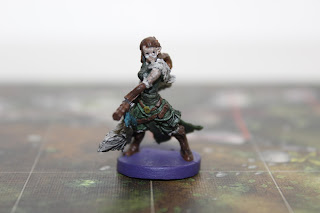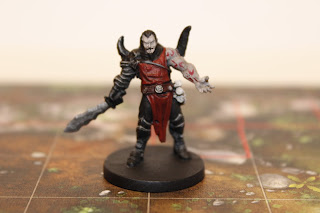For a long time I looked for a dungeon-delving board game the likes of Milton Bradley's HeroQuest, which I had largely ignored as a teenager in favor of more complex RPGs like Dungeons and Dragons. As an adult and father, I wanted something easier to teach my kids and to play in a single sitting, with more emphasis on miniatures than role-playing. Unfortunately, HeroQuest is outdated, and maybe slightly too simplistic. After checking out some of D&D's own beginner games and others like it, I decided Descent: Journeys in the Dark Second Edition was the best combination of quality, quantity, and compelling rules. Though not perfect and certainly a bit more complicated than advertised, it has been an extremely enjoyable hobby. I've been playing for a few years now, primarily with a group of friends in a monthly game night, but also with my wife and kids.
One thing I knew I'd never do, though, is paint the little plastic miniatures, which is otherwise a time-honored tradition in this arena. I just wasn't committed enough and doubted my artistic ability. Then my brother Michael - one of the regular players in my monthly group - acquired Imperial Assault, a Star Wars-themed version of Descent made by the same company (Fantasy Flight Games). He quickly painted his miniatures, and realizing he had a knack for it, offered to paint some of mine, too. Since I own the base game of Descent and most of the expansions, I doubted he'd be able to paint very many of them. Instead, he has now nearly finished my current collection, and the results have been phenomenal!
I never could have guessed how much it adds to the experience to play with painted figures. Some might wish they came painted already, but I've thoroughly enjoyed waiting to see my brother's latest work. Though I've been a bit stingy about sticking to the artwork, he has added just enough creative touches and stylistic choices for these to bear his signature, which is way more meaningful to me than figures painted in a factory. So naturally, I have to show them off! I can't do it all in one post, so to start out, here are the figures from the base game campaign, "The Shadow Rune." Michael took the pictures, too, but stood them on Imperial Assault map tiles because he didn't have access to mine (they look identical from a distance).
HEROES
Pictured first are the hero figures. The base game comes with eight, a male and female character representing each archetype (Warrior, Mage, Healer, and Scout). Archetypes determine which classes are available for you to choose. The base game comes with eight classes, two for each archetype. Though each of these heroes was designed as a match for one of those classes, the rules allow you to choose. For example, Syndrael makes a better Knight thematically, and Grisban is clearly a Berserker; however, since both are Warriors, you could choose either class for either hero. (The class options open up even further with additional expansions.) My brother painted the heroes' bases the color of their archetype, which I think adds nice continuity between the figure and the class cards (which are similarly colored). Unlike RPGs and other similar fantasy games, the characters' races are purely thematic and have no bearing on gameplay, but I noted them anyway.
 |
| Syndrael (Elf Warrior) |
 |
| Grisban the Thirsty (Dwarf Warrior) |
 |
| Widow Tarha (Orc Mage) |
 |
| Leoric of the Book (Human Mage) |
 |
| Ashrian (Elf Healer) |
 |
| Avric Albright (Human Healer) |
 |
| Jain Fairwood (Human Scout) |
 |
| Tomble Burrowell (Gnome Scout) |
MONSTERS
In
Descent, one player is called the Overlord and controls all the villains. Unlike the GM in an RPG, this player is actively trying to win the game. Each quest gives him options for which monsters to choose, all of which have their own strengths and weaknesses. Monsters of the same type are called a group, and the number of figures you're allowed to deploy from one group scales according to the number of heroes in play (2-4). One or two monsters from a group, called "masters," are stronger than the others and come as red miniatures; the others, "minions," come white. To reflect this, it's common to paint the masters' bases red, but Michael also added slight thematic differences where possible.
 |
| Cave spiders |
 |
Barghests
(We call them zombie dogs.) |
 |
| Zombies |
 |
| Goblin archers |
 |
Flesh moulders
(We call them Flesh Mulders and Scullys.) |
 |
| Ettins |
 |
Merriods
(We call them sharktopuses.) |
 |
| Elementals |
 |
| Shadow dragons |
LIEUTENANTS
In Descent, lieutenants are bosses, and a campaign's story revolves around them and their nefarious undertakings. In terms of attributes and toughness, they have more in common with heroes than regular monsters. New ones appear in every expansion, but unfortunately, cardboard tokens with their pictures on them are provided instead of miniatures. This gives incentive to buy the Lieutenant Packs: miniatures sold separately. They do come with additional rules and components that allow you to add a single lieutenant into a campaign as an "agent," but I haven't been won over by those rules and so usually only buy the packs for the figures. As such, I don't have all of them yet, but here are three out of the six lieutenants belonging to the "Shadow Rune" campaign:
 |
| Splig, aka the Fat Goblin |
 |
| Belthir |
 |
Baron Zachareth
(Main boss of "The Shadow Rune" campaign.) |
I'll post the painted miniatures from other expansions soon. In the meantime, if you like Michael's work and are interested in other kinds of crafts he's made, be sure to visit his Etsy store
LumberYarn.





















No comments:
Post a Comment